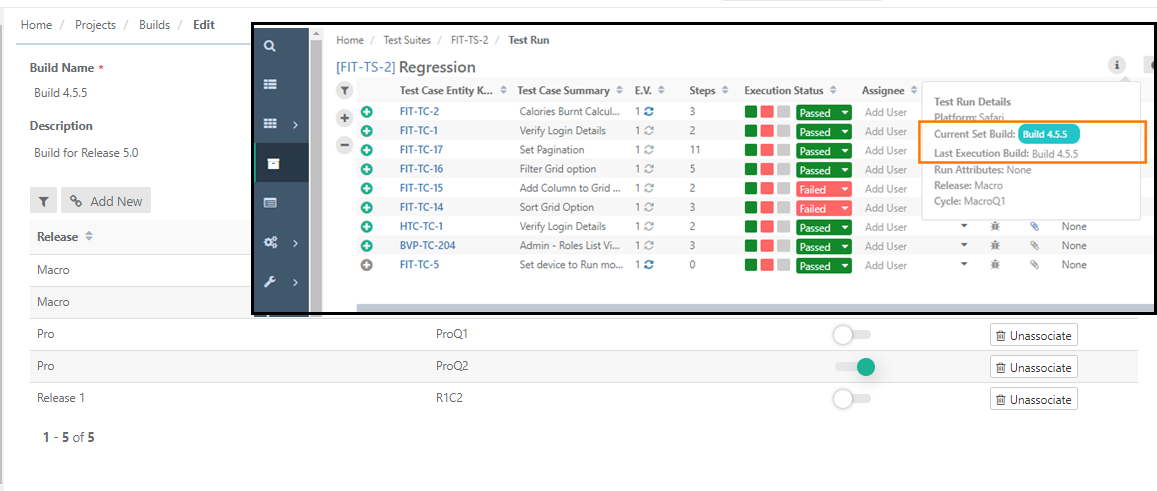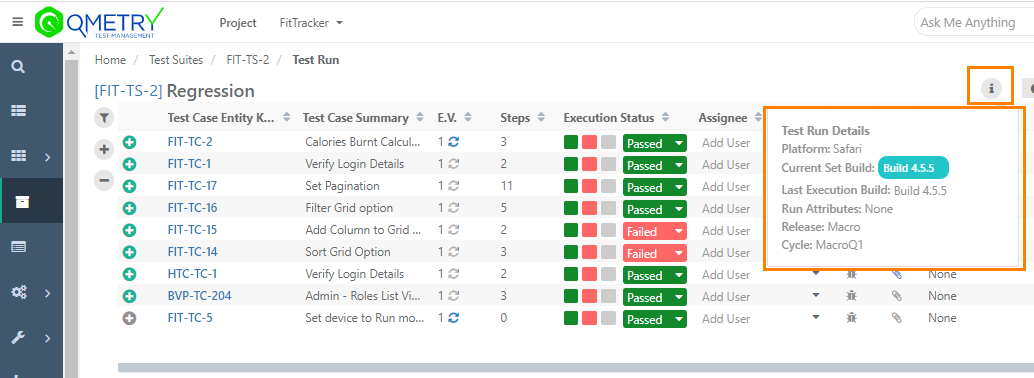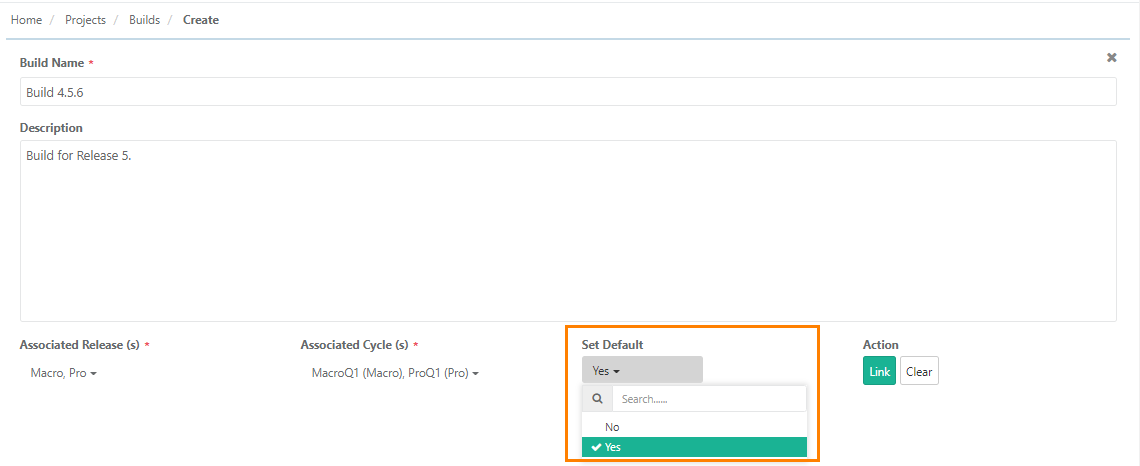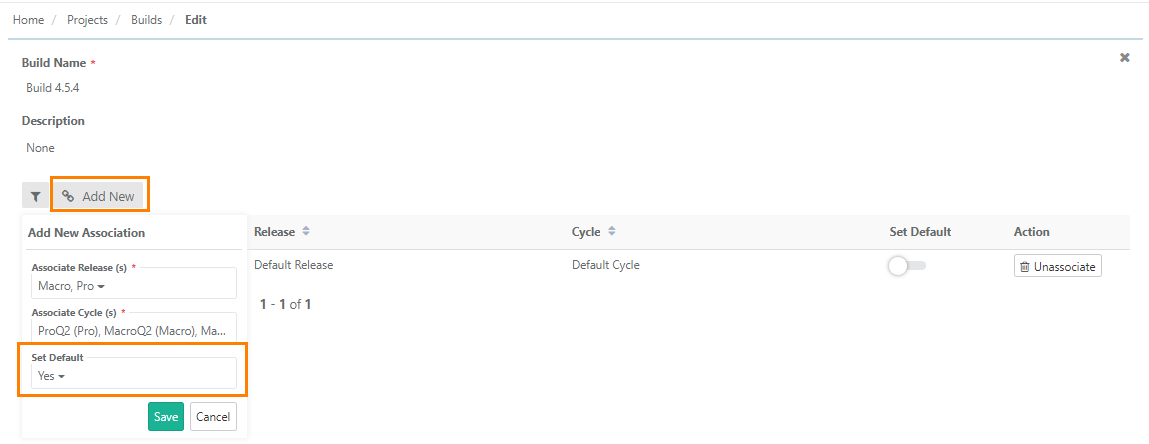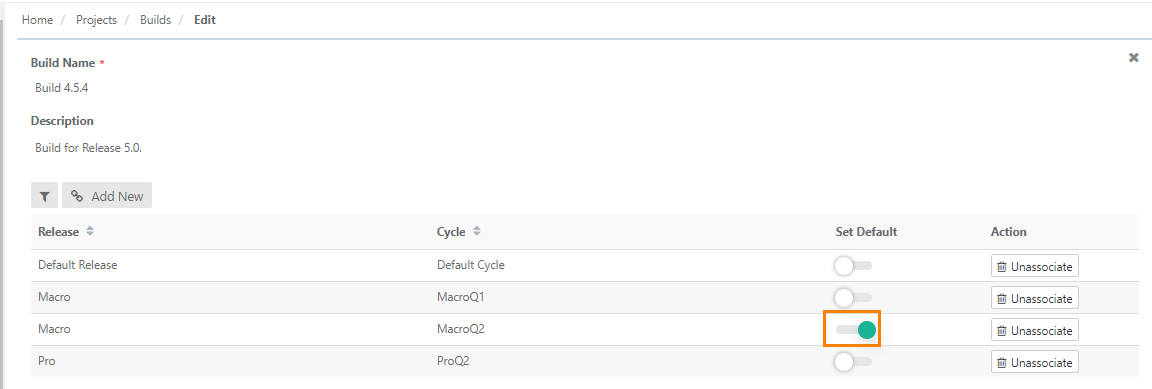QMetry defines a Build as a specific iteration of the product/domain to be tested. The feature allows the tester to assign a "build" (aka patch, drop, or increment) to test suites/test cases that indicates the version of product being tested. It helps users track multiple builds of software more dynamically without having to add separate test suites with every new build.
Note: The build should be already added and associated to Release and Cycle, which are associated with the test execution. Read more about Managing Builds.
| Table of Contents |
|---|
Build assignments are done at two levels:
...
Build can be assigned for the entire test suite. All the test cases in the test suite are executed on the build assigned at the test suite level. This option is available for customers having a Base package.
Set Build for Individual Test Cases
...
If you have enabled the Make Build selection mandatory during execution option in the Projects module, you can see the tip “Build is set as Mandatory during execution” on the Build grid (Projects > Builds).
...
Tester will see the following message when If the Build Selection is mandatory in the project and no build is selected on the execution screen, the tester will see the following message.
...
2. Set a Default Build for a release cycle combination.
QA Mangers can set a default build for a release & cycle combination so that test executions are auto assigned an intended build and testers do not have to set them manually. Tester The tester will still have an option to set another build other than the Default Build for the execution.
When a Default Build is set for a release cycle
All new executions will be assigned to the Default Build. Default Build will override already set builds, but will not change any existing test executions.
If a new build is set using “Set Your Build“ option, which is different than from the Default Build, the selected build would be valid only for that session. If you leave the execution screen or refresh, the selected build will be reset to Default Build.
When no Default Build is set for a release cycle
When executing test cases, if the tester sets a build, then the test case execution sets the executed build as the selected build.
The last build that was set for the test case always gets set as the executed build, if going forward build is not selected during execution.
When executing test cases, if the tester does not set a build then the test execution sets the executed build as None.
...
For a given release cycle combination, only one build can be set as a default build.
Users can set default build for a release cycle combination while creating a new build or while editing an existing build.
Users having roles with modify the “Modify” build permissions, can set builds to default.
Refer to the following screenshot to understand about the Current set build and last execution build.
When the Default Build is set, the Current Executed Build is auto-set as the default build.
When Default Build is Archived - the last execution build for the test suite will be set.
When Last Execution Build is Archived, with a default build present - Current Set Build and Last Execution Build changes to Default Build
When Default Build and Last Execution build are Archived - Current Set Build and Last Execution Build will be set to None.
...
The set default build for a release and cycle will be displayed at the test suite run level on the execution screen every time.
...
Current set build (i.e. set default build): The build set as default in the Build module. This is a test suite level build. You can change the build at the test suite level and the same is displayed as the Current set build until you refresh the execution screen.
Last execution build: The build set for test cases on the execution screen and on which the test case(s) are executed.
...
Use Case: QA Manager wants a default build for a combination of release/cycle, so that when test cases are executed against a release cycle combination and if the tester does not choose a build, they get executed against a default build. Tester is prompted for a confirmation that the execution will be done against a default build.
...
For example,
Build B1 is set as default build for release R1 and cycle C1.
Build B2 is also created in R1 and C1.
If the user tries to set build B2 as the default build, in that case, the earlier selection of default build (B1) will reset and the new build (B2) will be set as a default build for that Release & Cycle.
If the default build is set for particular release/cycle then this default build is set automatically at the time of adding the test run. A confirmation message pops up asking whether to continue the execution on the given default build.
Note: Bulk Execution performed on the Bulk Execute screen (Test Suite > Test Execution tab > Bulk Execute) is exempted from the application of default build. All the bulk executions from this screen will be performed on None build.
Create Build and Set it as Default
While creating a new build, the Set Default drop-down with Yes/No options is available to mark the build as default.
Set Default - Yes : The build will be set as a default build on the execution screen for the selected Release Cycle combination.
Testers do not need to remember and set the build manually every time. This also helps them to reduce build association errors.
QA Manager can always set the current build as a Default Build to ensure the executions are always associated to the current build.
Only one default build can be set for a given combination of a Release Cycle.
Set Default - No : Makes the Build as non-default. When some other build is set to default, this flag will be set to “No” for the previously default build.
...
Edit Build and Set it as Default
...
You can mark the build as default either while adding new Release(s) & Cycle(s) to the build. You can mark the build as default build for multiple combinations of Release(s) & Cycle(s) at a time.
...
You can mark the build as default after adding new Release & Cycle to the build.
...
You can view the Release(s) & Cycle(s) that are associated with the default build on the Build grid in Projects > Builds.
...
On Execution Screen -
...
All Test Cases are selected while selecting build OR
No Test Cases are selected while setting the build.
...
4. Set Build at Test Case Level
...
Current set build (i.e. set default build): The build set as default in the Build module. This is a test suite level build. You can change the build at test suite level and the same is displayed as Current set build until you refresh the execution screen.
Last executed build: The build set for test cases on execution screen and on which the test case(s) are executed.
...
